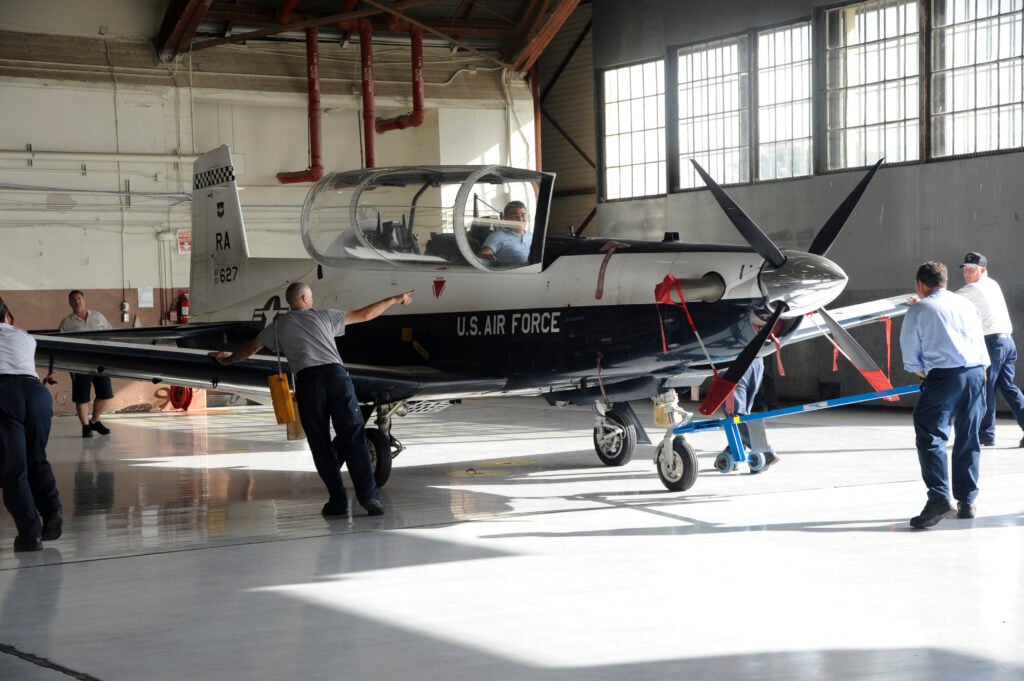
Air Force T-6 training aircraft
WASHINGTON: The Air Force is pursing a number of initiatives to modernize and speed pilot training, including making changes to integrate the new T-7A Red Hawk aircraft system into the service’s training regime.
“It is imperative that we do this aggressively, taking full advantage of our partnerships with industry, because the Air Force pilot shortage is not just about 2020. It is about 2030 and beyond,” said Brig. Gen. Brenda Cartier, 19th Air Force vice commander.
The idea is to build on the flagship Pilot Training Next (PTN) experiment for primary training, launched in 2018, to create new paths for qualifying more pilots at a faster pace, she explained in a presentation late last month to the Institute for Defense and Government Advancement’s sixth annual Military Flight Training conference.
PTN, managed by Air Force Education and Training Command (AFETC), combines increased use of simulator technology with new teaching methodologies tailored to individual students for primary training. It started out small, with some 20 airmen at the Reserve Center at Austin-Bergstrom International Airport in Austin, Texas. The third PTN class graduated this year, Cartier said.
Whereas PTN is centered around Raytheon Aircraft’s T-6 (a military trainer version of Raytheon’s Beech/Pilatus PC-9 Mk II), it could also serve as the foundation for developing a training regime for the incoming Boeing/Saab T-7A, Cartier said.
“Going forward we could use PTN for an advanced pilot training experiment, what we’re calling APT-X – looking at how best to train in the upcoming T-7,” she said. “You see, the AF has a tendency to fly new airplanes like we flew old airplanes. We flew the F-22 like it was an F-15. We flew the F-15E like an F-111. APT-X will figure out how can we can fly the T-7 differently — not like a T-38. We have to be willing to embrace the future on that. ”
At the same time, the PTN program itself also is being upgraded, Cartier explained.
“Today, we are scaling the lessons learned and best practices of PTN, to bring pilot training into the 21st century as well as look for opportunities to increase production. We call this scaled-up version of Pilot Training Next – UPT 2.5,” she said. “In UPT 2.5 we’re beefing up the T-6 phase of training, we’re giving students more flying hours and we’re giving about 100 more Immersive Training Device, or ITD, hours.”
Student pilots will finish T-6 and related simulator training, get their wings, then go on to learn the fundamentals for flying either fighter or mobility aircraft, she said. Currently, the UPT 2.5 training curriculum is being debuted at Joint Base San Antonio-Randolph in Texas and Vance AFB in Oklahoma to assess whether it is ready to roll out across the service.
If the UPT 2.5 effort is successful, Cartier said, that will free up capacity to use the Raytheon T-1 Jayhawk twin engine plane to train airlift and tanker pilots. Thus, the Air Force has created the Accelerated Path to Wings program, known as XPW.
“We think XPW is interesting and important in our innovation efforts. We have a small group tryout going on here at [Joint Base San Antonio-Randolph], and we’re going to learn a lot. How many hours does it take? How many sims do we add? If you can get the right blend together and create a world class pilot that’s pretty important.”
Cartier said that if UPT 2.5 works the way the service wants it to, then once that effort is scaled up, the XPW program in turn will expand.
Further, the service is looking to revamp helicopter training, she said.
“On the helicopter side we’re experimenting with Helo Training Next. We’re going to send helo pilots through a helicopter only path to wings. This will free up 60-80 slots per year from T-6s and make those available for fixed wing pilot production,” she said.
Initially, this comprises two “Small Group Tryouts:” one that started at Ft. Rucker in Alabama, using the Bell’s TH-1H Iroquois; another at Georgetown, Texas using the Bell 206 to get civilian training first, then moving to Ft. Rucker, she said.






















